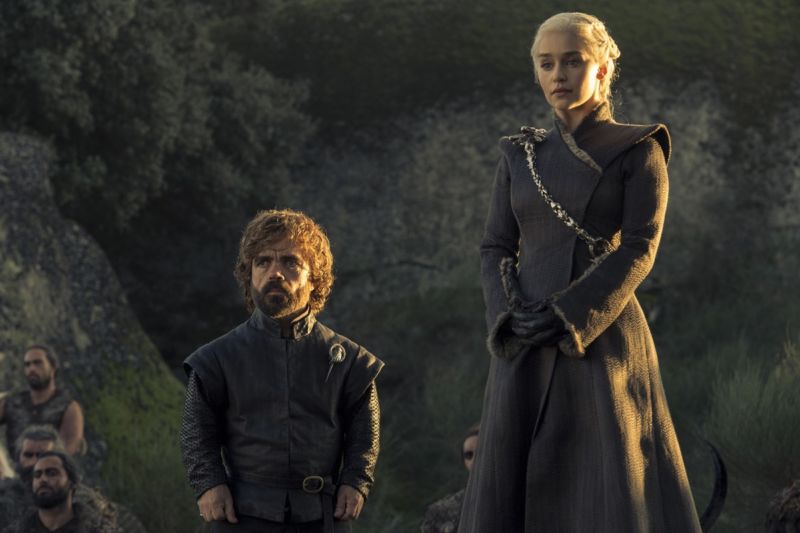
HBO
Game of Thrones boasts one of the highest body counts on TV, knocking off even major characters in some very gruesome ways. Perhaps even more surprising is who still survives as we head into the final season. A new paper in the journal Injury Epidemiology offers some insights into the best strategies to ensure survival in the brutal world of Westeros.
(Some spoilers for first seven seasons below.)
This isn’t the first time Game of Thrones has inspired a scientific paper. One 2016 study examined the Greyscale skin disease, while a 2017 study explored fight or flight responses of various characters on the show. And there was a lively discussion among chemists over what real poison was most similar to “The Strangler” used at the infamous Purple Wedding in season 4.
But nobody had taken an in-depth look at the show’s epidemiology. So Reidar Lystad of the Australian Institute of Health Innovation at Macquarie University in Sydney, and his colleague Benjamin Brown, decided to do just that. They admit that this gave them the perfect excuse to re-watch all 67 episodes of the first seven seasons before the final season airs in April, because Lystad and Brown are uber-fans.
More than half of the characters had died by the end of the seventh season, usually by violent means.
Not surprisingly, the study found that the risk of death for a Game of Thrones character is remarkably high. More than half (186 out of the 330 characters included in the study) had died by the end of the seventh season, usually by violent means (decapitations, stabbings, poison, hanging, strangulation, burning, slit throats, wild dogs, arrows, sword thrusts, one memorable crushed head, and of course, being pushed from a very high place). Actors, take note: there was a 14 percent probability of dying in the first hour after appearing on screen for the first time.
“While these findings may not be surprising for regular viewers, we have identified several factors that may be associated with better or worse survival, which may help us to speculate about who will prevail in the final season,” said Lystad.
Who will survive?
-
Survival curves for important characters in Game of Thrones, stratified by sex (a) and social status (b).
Lystad and Brown -
Survival curves for important characters in Game of Thrones, stratified by whether the character switched allegiance during the show (c), and how prominently the character featured in the show (d).
Lystad and Brown
So how did someone like Sansa Stark—originally a whiny, spoiled hothouse orchid—manage to outlive so many of her doomed family members? Being highborn lowers one’s risk of violent death; so does being female. But ultimately it’s those who show a willingness to forge unusual alliances, or switch their allegiances, who have the best chance of survival. (It’s probably a good idea to avoid weddings, too.)
Sansa showed a remarkable ability to adapt to her horrible circumstances, developing a degree of moral flexibility that enabled her to do what was necessary to win—unlike so many of her highly principled family members. Tyrion Lannister had his quick wit, wealth, and a few lucky breaks, but this analysis suggests it was his willingness to break with his family and join forces with Daenerys Targaryen that got him to the final round. It was the low-born Littlefinger’s constant shifting allegiances as various family fortunes changed that kept him in the game for so long, until his machinations finally caught up with him.
The analysis comes with a few caveats. Lystad and Brown only included important characters in their analysis, so it might not be possible to generalize their findings to the entire fictional population. Also, there could be errors in their data. The authors relied on their own independent data collection (re-watching the DVD boxed set), cross-referencing their data with online resources such as the Internet Movie Database (IMDB) and the Game of Thrones Wiki. But they feel fairly confident in the accuracy of the data on the Wiki in particular.
“The information has been collaboratively reviewed by thousands of die-hard fans,” they write, “including fans who have developed strong parasocial relationships, to the extent that overt grief was observed after the death of certain characters in the show.” In other words, super-fans are super emotionally invested in the world of Westeros, and experience genuine real-world emotions in response to the fictional events. So they want that Wiki to get the facts right.
Death becomes them
-
Ned Stark was just too honorable for his own good.
HBO -
Viserys Targaryen got a crown of gold for his lack of diplomatic skill.
HBO -
Catelyn Stark didn’t see Walter Frey’s betrayal coming.
HBO -
Be honest, you cheered when sadistic boy-king Joffrey started choking at the Purple Wedding.
HBO -
Still bitter (and grossed out) about the Red Viper’s fate.
HBO -
Jon Snow tried to do the right thing and got stabbed by his own men for his trouble.
HBO -
Pro tip: if you’re going to mutiny and stab your leader to death, make sure he stays dead.
HBO -
Myrcella Baratheon’s fate was sealed with a poisoned kiss.
HBO -
Death of an innocent: Shireen Baratheon paid the price for her father, Stannis Baratheon’s, vaunting ambition.
HBO -
“Hold the door….” Hodor makes the ultimate sacrifice. I’m not crying, you’re crying.
HBO -
King Tommen Baratheon just can’t live in this world anymore.
HBO -
Payback’s a bitch, Walter Frey.
HBO -
Sansa’s flexibility got her all the way to the final season.
HBO
The world of Game of Thrones is fictional, but author George R.R. Martin has said that its creation was inspired by real historical events, most notably England’s Wars of the Roses in the late 15th century. That’s “wars,” plural, since there were several outbreaks over 30 years as the houses of York (symbol: white rose) and Lancaster (symbol: red rose) fought for control of the throne. So it’s not surprising that the world of Westeros has a medieval feel to it, marked by “political upheaval, civil wars, and widespread violence,” the authors note.
Lystad and Brown assert that there is great potential for preventing violence in the world of Game of Thrones. Much of the unrest, they argue, is due to “ceaseless feuding and the lack of stable democratic government,” with more of an emphasis on war than commerce, as various factions jockey for the Iron Throne. This, in turn, impedes the widespread establishment of schools, hospitals, and other societal structures that could improve the health and overall well-being of the inhabitants.
If Westeros managed to stabilize its government, expand commerce, invest in public institutions and infrastructure, and emphasize knowledge and reason when setting policy, that would go a long way to reducing the violence over time. Of course, that would kill all the dramatic tension and the show’s popularity would plummet. Hence, the authors conclude, “It seems unlikely any such changes will occur before the last episode of the final season reaches television screens worldwide.”
DOI: Injury Epidemiology, 2018. 10.1186/s40621-018-0174-7 (About DOIs).



















![[Book Review] The Blade Itself (The First Law Trilogy) by Joe Abercrombie](https://bendthekneegot.com/wp-content/uploads/2018/01/1516047103_maxresdefault-218x150.jpg)

















